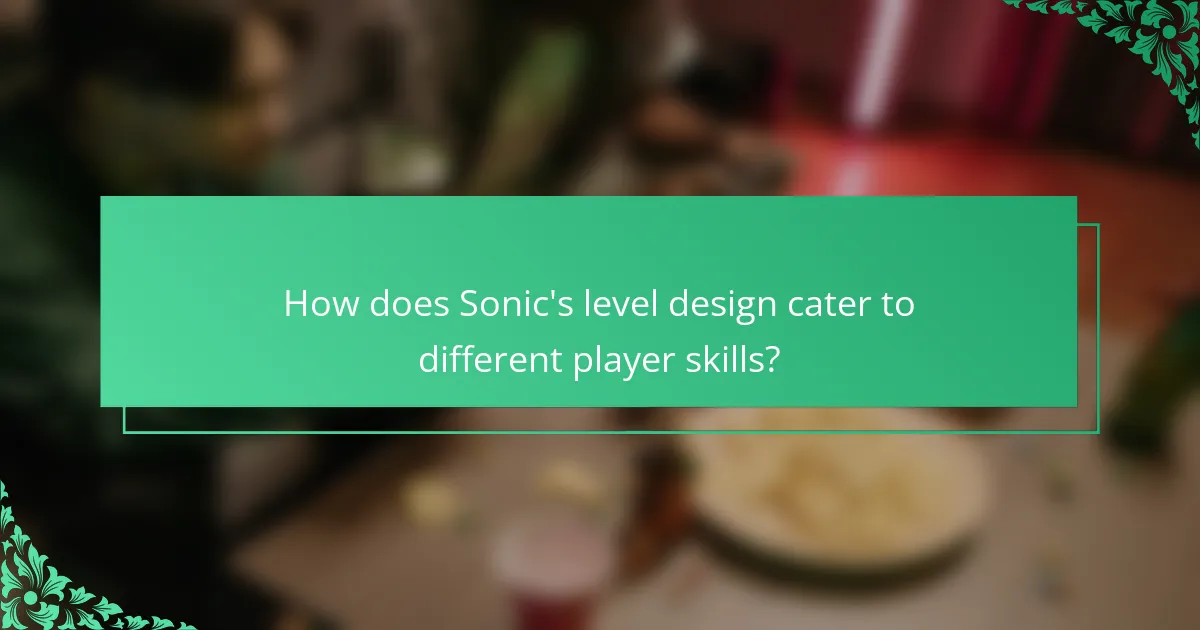Sonic the Hedgehog’s level design focuses on speed and exploration, featuring diverse pathways and dynamic elements. The character has evolved significantly, showcasing deeper narratives and unique abilities. Fan creations highlight the community’s creativity and passion for the franchise. This article explores these insights into level design, character evolution, and the impact of fan contributions.

What are the key principles of Sonic the Hedgehog level design?
Sonic the Hedgehog level design emphasizes speed, flow, and exploration. Key principles include diverse pathways, verticality, and momentum-based gameplay. Each level encourages players to experiment with routes, enhancing replayability. Additionally, iconic elements like loop-de-loops and springs create dynamic movement, reinforcing the character’s identity.
How do level layouts influence gameplay dynamics?
Level layouts significantly shape gameplay dynamics by influencing player movement, strategy, and engagement. In Sonic the Hedgehog, level design incorporates speed, verticality, and obstacles that challenge players while enhancing the character’s agility and abilities. Unique attributes like loop-de-loops and ramps create a distinct play experience, encouraging exploration and skill mastery. Rare elements, such as hidden paths or alternate routes, further enrich gameplay, promoting replayability and player creativity in navigating levels.
What role do obstacles and enemies play in level progression?
Obstacles and enemies enhance level progression by providing challenges that test player skills. These elements create tension and excitement, motivating players to improve. In Sonic the Hedgehog, obstacles like spikes and enemies such as Dr. Robotnik force players to navigate levels strategically. This interaction fosters a sense of achievement upon overcoming challenges, enriching the gaming experience. Additionally, varied enemy types and obstacle designs contribute to unique gameplay moments, ensuring each level remains engaging and dynamic.
How does visual design impact player experience?
Visual design significantly enhances player experience by creating immersive environments and emotional connections. In “Sonic the Hedgehog,” vibrant colors and dynamic level layouts engage players, promoting exploration and excitement. Effective visual design influences gameplay mechanics, guiding player actions and decisions. Additionally, character evolution is visually represented, deepening player attachment and investment in the game.

How has Sonic the Hedgehog’s character evolved over the years?
Sonic the Hedgehog has evolved from a simple mascot to a complex character with rich narratives. Initially designed for speed and attitude, Sonic’s personality expanded to include deeper emotions and relationships. Over the years, games introduced unique abilities, such as the homing attack and spin dash, enhancing gameplay. Rarely, Sonic’s character faced darker themes, reflecting maturity in storytelling. Unique attributes like his friendships with Tails and Knuckles added depth, while fan creations further showcase his cultural impact. This evolution demonstrates Sonic’s adaptability to changing gaming landscapes and audience expectations.
What are the defining traits of Sonic’s character design?
Sonic’s character design features distinct traits like his blue color, spiky quills, and red shoes. His design emphasizes speed and agility. The unique attribute of his anthropomorphic hedgehog form sets him apart in the gaming world. Sonic’s expressive eyes and confident posture reinforce his adventurous personality.
How have story arcs contributed to character development?
Story arcs significantly enhance character development by providing structured narratives that allow characters to grow and evolve. In “Sonic the Hedgehog,” character arcs illustrate transformation through challenges faced in various levels. For instance, Sonic’s encounters with Dr. Robotnik showcase his resilience and determination, reinforcing his heroic persona. Additionally, supporting characters like Tails and Knuckles experience their own arcs, adding depth to the storyline and enriching player engagement. These character developments are essential for creating a compelling gaming experience that resonates with fans and encourages creative expressions within the community.
Which other characters have influenced Sonic’s evolution?
Tails, Knuckles, and Shadow have significantly influenced Sonic’s evolution. Tails introduced cooperative gameplay, enhancing Sonic’s adventures. Knuckles added depth with his treasure-hunting abilities, while Shadow brought a darker narrative element. Together, they shaped Sonic’s character dynamics and gameplay mechanics.

What are the most notable fan creations in the Sonic the Hedgehog community?
The Sonic the Hedgehog community is known for its impressive fan creations, including fan games, artwork, and animations. Notable examples include “Sonic Mania,” a fan-made game that gained official recognition, and various animated series that showcase unique storytelling. Additionally, fan art often reimagines characters in innovative ways, contributing to the franchise’s cultural richness. These creations highlight the community’s passion and creativity surrounding Sonic the Hedgehog.
How do fan games reinterpret Sonic’s gameplay mechanics?
Fan games reinterpret Sonic’s gameplay mechanics by innovating level design and character abilities. These creations often feature unique environments that enhance speed and exploration. Fan developers introduce new power-ups, enabling diverse gameplay styles. Additionally, they experiment with physics, creating varied experiences that challenge traditional mechanics. This evolution showcases the community’s creativity and passion for the Sonic franchise.
What role does fan art play in the Sonic community?
Fan art plays a significant role in the Sonic community by fostering creativity and connection among fans. It allows individuals to express their interpretations of characters and stories, enhancing engagement with the franchise. Fan art also serves as a platform for collaboration, where artists share techniques and ideas, contributing to the community’s growth. Additionally, it can influence official content, as creators often draw inspiration from fan interpretations, showcasing the impact of fan contributions on the franchise’s evolution.
Which fan projects have gained significant recognition?
Several fan projects related to Sonic the Hedgehog have gained significant recognition, showcasing creativity and dedication. Notable examples include Sonic Mania, which revitalized classic gameplay, and Sonic Fan Remix, praised for its impressive graphics and level design. Additionally, Sonic Dreams Collection gained attention for its unique and experimental approach to the franchise. These projects illustrate the passion and innovation within the Sonic fan community.

How does Sonic’s level design cater to different player skills?
Sonic’s level design accommodates various player skills through diverse pathways and challenges. Levels feature multiple routes, allowing skilled players to access faster, more complex areas while novice players can take simpler paths. This design encourages exploration and mastery, catering to different play styles. Additionally, power-ups and checkpoints support players at varying skill levels, ensuring a balanced experience. The incorporation of speed and platforming elements further enhances engagement, making Sonic accessible yet challenging for all players.
What strategies are employed to balance challenge and accessibility?
Balancing challenge and accessibility in Sonic the Hedgehog involves strategic level design, character abilities, and player feedback mechanisms. Designers create levels that gradually increase in difficulty while incorporating varied pathways and power-ups. This ensures that both novice and experienced players can enjoy the game. Additionally, character evolution, such as the introduction of new abilities, enhances gameplay and maintains engagement. Regular updates based on community feedback help to refine challenges, ensuring they remain enjoyable and fair.
How do speedrun techniques affect level design considerations?
Speedrun techniques significantly influence level design by prioritizing speed, efficiency, and player movement. Designers often create levels that support shortcuts, optimized paths, and minimizing obstacles. This approach enhances gameplay fluidity and player engagement. For instance, Sonic the Hedgehog levels incorporate slopes and loops to facilitate rapid traversal. As a result, level design must balance challenge with speedrun viability to appeal to both casual and competitive players.

What unique gameplay mechanics have emerged in Sonic games?
Unique gameplay mechanics in Sonic games include speed-based platforming, momentum-driven physics, and alternate pathways. These elements encourage exploration and quick reflexes, enhancing player engagement. Additionally, the introduction of character-specific abilities, such as Tails’ flight and Knuckles’ climbing, adds depth to gameplay. Recent titles have incorporated 3D environments that blend traditional 2D gameplay with open-world exploration, creating a dynamic experience.
How do power-ups enhance player engagement?
Power-ups significantly enhance player engagement by providing immediate rewards and strategic advantages. They introduce dynamic gameplay elements that encourage exploration and experimentation. Players are motivated to seek out power-ups, which can lead to increased playtime and satisfaction. Unique power-ups in “Sonic the Hedgehog” offer distinct abilities, enhancing character evolution and level design. These elements create a more immersive experience, fostering a deeper connection between players and the game.
Which mechanics have been introduced in recent titles?
Recent titles in the Sonic the Hedgehog series have introduced mechanics like parkour elements, enhanced speed boosts, and dynamic level transitions. These innovations enhance gameplay fluidity and encourage exploration. For instance, the incorporation of 3D environments allows characters to interact with the world in new ways, promoting unique gameplay experiences. Additionally, character abilities have evolved, introducing new skills that align with each character’s narrative.

What are common pitfalls in Sonic level design to avoid?
Common pitfalls in Sonic level design include excessive linearity, lack of player guidance, poor pacing, and inadequate enemy placement. These issues can hinder gameplay flow and frustrate players.
Excessive linearity restricts exploration, making levels feel monotonous. Lack of player guidance can lead to confusion, especially in complex areas. Poor pacing disrupts the rhythm of gameplay, while inadequate enemy placement can result in unchallenging or overwhelming scenarios, diminishing the overall experience.
To create engaging levels, ensure a balance between speed and exploration, provide clear visual cues, maintain a varied enemy presence, and design for smooth transitions in gameplay.
How can designers ensure a smooth learning curve?
Designers can ensure a smooth learning curve by incorporating intuitive level design and character mechanics. Engaging tutorials and gradual difficulty progression help players adapt. Feedback systems, such as visual cues and responsive controls, enhance player understanding. Additionally, analyzing player behavior allows designers to refine experiences, making them more accessible and enjoyable.
What mistakes lead to frustrating player experiences?
Poor level design, unbalanced character abilities, and lack of player feedback lead to frustrating experiences in Sonic the Hedgehog. Inadequate checkpoints can increase player frustration, especially during difficult sections. Additionally, overly complex level layouts may confuse players, detracting from the game’s fast-paced nature. Lastly, failing to incorporate fan feedback can result in missed opportunities for improvement and innovation in character evolution.
How can feedback from the community improve level design?
Feedback from the community can significantly enhance level design by incorporating player insights and preferences. Engaging with fans allows designers to understand gameplay experiences, identify challenges, and discover desired features. For instance, constructive criticism can lead to refined mechanics, improved layouts, and innovative elements that resonate with players. Additionally, community-driven ideas can inspire new levels or adaptations, fostering a collaborative environment that enriches the Sonic the Hedgehog franchise.
What best practices should be followed for effective level design?
Effective level design requires a focus on player experience, flow, and engagement. Prioritize clear objectives and intuitive pathways. Incorporate varied challenges, ensuring difficulty scales appropriately. Use visual cues to guide players while maintaining an immersive environment. Regular playtesting helps refine levels based on feedback, enhancing overall enjoyment.


